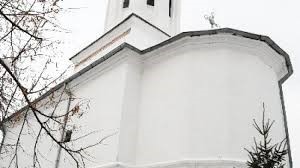Churches and Monasteries
- Ariana Mihailoiu
- Feb 19, 2021
- 4 min read
Updated: Nov 4, 2023
RELIGIOUS ROUTE
Saint Nicholas Curch
Historical monument address: Alexandru Odobescu street, Dolj country. Founder and historical evidence: the brick church started to be built in 1793 by some founders and totally finishes by Ionita Stancescu and the fishers’ guild in 1839. The church has the shape of a cross and also has a bell. According to the official writing from old books of the church, in 1849 there was a school in the yard of the church under the coordination of theacher Dimitrie Popescu.
The Evangelical Lutheran Church (of Augustan confession)
Historical monument address: 13 Unirii Road, Craiova city, near Jean Mihail Palace (today’s Art Museum).
Founder and historical evidence: the Evangelical Lutheran Church was built between 1870 and 1872 in Neo-Renaissance architectural style according to the architect Lindhorst’s design. It is the oldest Protestant curch in Oltenia region. The community of evangelical Christians from Craiova city was formed around the half of the 19th century when protestants of different confessions:the Germans (Transilvanian Saxons, Austrians, Prussian, German from Russia) and the English temporarly or permanently moved into the city.
Mantuleasa Church
Founders and historical evidence:Mantuleasa Church is dedicated to the “Dormition of Virgin Mary” and “Saint Pantaleon” and is a historical and architerctul monument of local interest. The church dated 1896 was set up on the place of a former religious eidifice established in 1786.Oil-based paint was used for the church interior walls. Mantuleasa Church is considered one of the edifices in Craiova which preserved its initial layout. The building is surrounded by other historical monuments significant for Craiova city, including Varvoreanu House, Nicolae Romanescu House, Feraru House and Grigorescu House.
“Saint Demetrius” Metropolitan Cathedral
Historical monument address: 14 Matei Basarab street, Craiova city
Founders and historical evidence: The Monastery of “Saint Demetrius the Great Martyr”is the oldest religious edifice in Craiova and it was first mentioned as “Voievod’s Church of Craiova” in the year 1645. The first church fouder is boyar Barbu Craiovescu, member of the Craiovesti family. The monastery was rebuilt from the ground, as ordered by Matei Basarab in 1651. Great armas Petru Obedeanu, the official in charge for prisioners, had it repaired in 1690. The monastery was declared metropolitan cathedral in 1939.
Hagi Enusi Church
Hagi Enusi Church from Alexandru Ioan Cuza Street no. 67 is built at the end of the 18th century and the beginning of the next one, between 1792-1800. Among the founders of the church were Dumitrache Sandulache, Ion Băcanu, Mihai Cojocaru, Ion Săpunaru.
Madonna Dudu Church
The church, located on Madona Street no. 13, has the name, given in the 18th century, closely related to the legend according to which in the orchard that once stretched in the place where the church is built, the icon of the Mother of God was found in a mulberry tree. Taken from there and taken to the church, she disappeared and was found again in the mulberry tree in the orchard. The owner of the place, an ancestor of the clucer Chiriac Găianu, then built a small wooden church, as a cover for this icon.
Between 1758-1760 the wooden church was replaced by a larger one, built of stone by the merchant Hagi Gheorghe Ioan and the clucer Constantin Fotescu. The church was built in Brancoveanu style.
The Church of the Holy Apostles
The Church of the Holy Apostles, on the street of the Holy Apostles, was known as the “Church of Popii Hristea”, after the name of the poet Hristea who built it out of brick. But the beginnings of the church are much older. The Church of the Holy Apostles must have existed long before the eighteenth century.
Obedeanu Church
Carrying the patron saint “Buna Vestire”, the church that is now next to School no. 1 Craiova, on Brestei Street, was built in the first half of the 18th century, 1748 - 1753, by the great cupbearer Constantin Obedeanu.
The settlement was originally a monastery and hospital. In 1775, the “princely school from the Obedean Monastery” was built here, and in 1822, the public school next to the Obedeanu Monastery became the “princely school”, where it was taught not only in romanian, but also in french and greek.
St. Elijah's Church
Located in the center of Craiova, on C.S. Nicolaescu Plopsor, opposite the prefecture's headquarters, St. Elijah's Church is the second wall church in Craiova, built in the 18th century, after St. Dumitru's church. The foundation of the vornic Ilie Otetelişanu dates from 1720.
St. Spiridon's Church
The "Saint Spiridon" Church is located on a small hill in the heart of Craiova, not far from the National Theater and the University. It is the foundation of the Vlădăieni boyars, built in 1758, during the reign of Constantin Nicolae Mavrocordat and the bishop of Râmnic Grigorie.
Holy Trinity Church of Stirbei
The Holy Trinity Church is located in 9 Ion Maiorescu Street (former Barbu Ştirbei), in front of the Carol I National College. It was founded by Dumitrana Ştirbei, the widow of Constantin Ştirbei, between 1765-1768. The fact that the church began to be built in 1765 is proved by a document from December 15, 1765, which says that: "Dumitrana Ştirbei had built a church near her houses in Craiova".
The church was built on the outskirts of Craiova, in order to have the necessary extension for the "yard". The boyar courts around the churches were at first the first edge of the city, to later form the most developed center of Craiova.
All Saints Churchi
Str. Mihai Viteazu 10, 200417 Craiova (DJ). All Saints Parish was founded in 1827. The parish church was built in 1844 and consecrated by Bishop Giussepe-Maria Molajoni.















































Comments